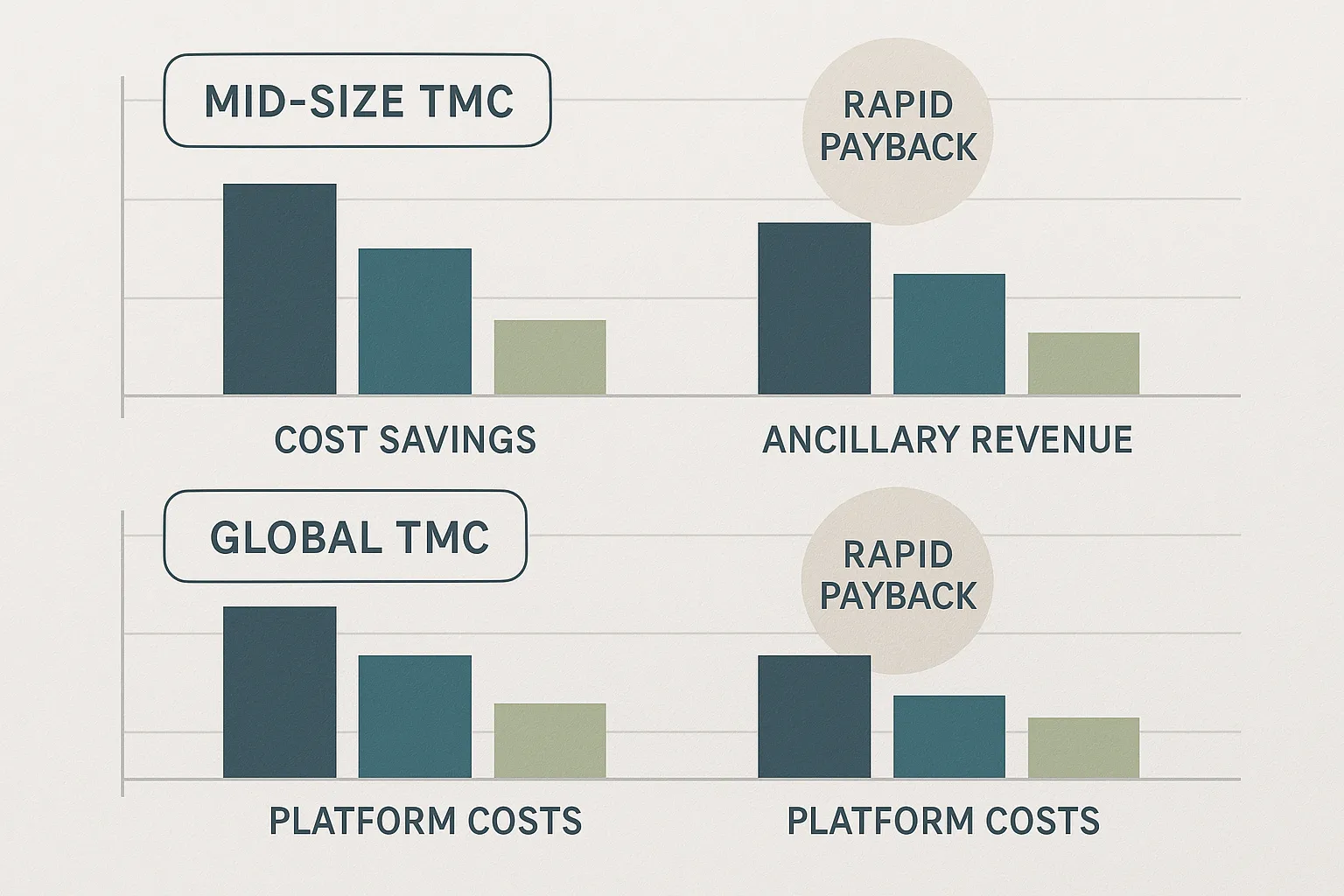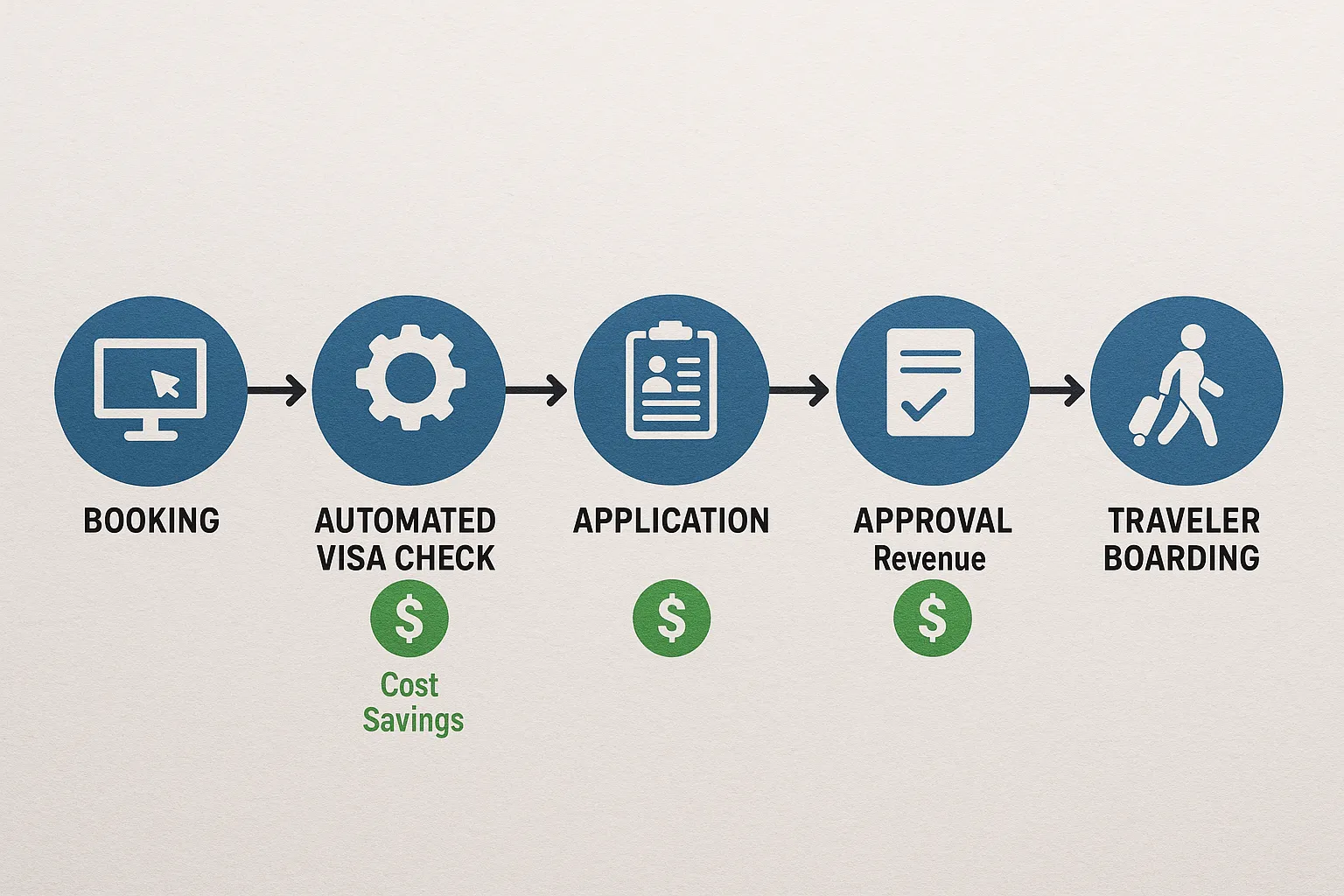The ROI of Travel Document Automation for TMCs: Case Models and Payback Periods

Compliance costs are rising, border regulations are in flux, and corporate travelers expect consumer-grade booking experiences. For Travel Management Companies (TMCs), the manual handling of visas, ETAs, and new mandates such as ETIAS is becoming a margin killer. Automating travel-document workflows is no longer a “nice to have” but a proven profit lever—if you can quantify the return on investment (ROI) and the payback period for your board or procurement team.
What We Mean by “Travel Document Automation”
Travel document automation refers to software that embeds visa eligibility checks, form pre-fill, eVisa submission, status tracking, and secure storage directly into the booking or post-booking flow. Platforms like SimpleVisa deliver these capabilities through:
- Plug-and-play APIs for online booking tools (OBTs)
- White-label web or mobile applications for offline agents and travelers
- Real-time data services that surface requirements and deadlines
The result is fewer denied boardings, higher traveler satisfaction, and an ancillary product you can sell at healthy margins.
The Cost Baseline: What Manual Processing Really Costs a TMC
Before modelling ROI, you need to capture the full cost of your current process. Based on GBTA and ACTE benchmark surveys (2024), the average corporate trip involves 12–15 minutes of agent time for checking entry rules and emailing instructions. That does not include:
- Rework when rules change (2–3 minutes per booking)
- Post-booking traveler questions (average 1.6 calls or chats)
- Out-of-policy visa denials at the gate (0.13% of international trips, but USD 1,475 average cost per incident according to IATA’s Timatic data)
| Cost Component | Typical Manual Value | Hidden Cost Driver |
|---|---|---|
| Agent time per booking | 15 minutes × USD 35/hr ≈ $8.75 | Wage inflation, turnover |
| Traveler support | 6 minutes × USD 25/hr ≈ $2.50 | After-hours escalations |
| Denied boarding write-offs | 0.13% × $1,475 ≈ $1.92 | Refunds, re-tickets, penalties |
| Total baseline cost | $13.17 per int’l booking | Excludes reputational impact |
For a mid-size TMC with 100 000 international segments a year, manual compliance silently drains $1.3 million in direct cost.
Where the ROI Comes From
- Labour savings – automated form pre-fill and real-time rule engines slash agent handling time to under three minutes, a 75% reduction.
- Fewer disruptions and fines – eligibility checks at booking reduce denied boardings by up to 70% (SimpleVisa network benchmark, 2025 YTD).
- Ancillary revenue – charging a convenience fee or sharing revenue on eVisa sales typically yields $7–$15 per attached visa.
- Client retention & RFP wins – corporates increasingly list automated visa compliance as a required capability.
A Simple ROI Formula
Annual Net Benefit = (Cost savings + Ancillary margin + Avoided disruption cost) – Platform cost
ROI (%) = (Annual Net Benefit / Platform cost) × 100
Payback Period = Platform cost / Monthly Net Benefit
Platform cost will vary by vendor and integration model (API vs no-code widget). For modelling, we assume a platform fee of $0.90 per eligible segment plus a one-off implementation cost of $25 000.
Case Model 1: Mid-Size Regional TMC
- 100 000 annual international segments
- 20% attach rate for automated visa service (grows to 28% in Year 2)
- $9 service fee retained per visa
| Metric | Year 1 Estimate |
|---|---|
| Agent time saved | 12 minutes × $35/hr × 100k = $700 000 |
| Support cost saved | $2.50 × 100k = $250 000 |
| Avoided disruption | $1.00 × 100k = $100 000 |
| Ancillary margin | 20 000 visas × $9 = $180 000 |
| Gross benefit | $1 230 000 |
| Platform variable fee | $0.90 × 100k = $90 000 |
| Implementation (once) | $25 000 |
| Net Year-1 benefit | $1 115 000 |
| ROI | 1 115 000 / 115 000 = 970% |
| Payback | $115 000 / $92.9k per month ≈ 1.2 months |
Even if attach rates stall at 10 %, payback remains under five months.
Case Model 2: Global Mega-TMC
- 1 million annual international segments
- 15 international call-centres with blended wage of $28/hr
- 25% visa attach rate, $8 margin per visa
| Metric | Year 1 Estimate |
|---|---|
| Labour + support saved | $11.25 × 1 M = $11.25 M |
| Avoided disruption | $965 000 |
| Ancillary margin | 250 000 × $8 = $2 M |
| Gross benefit | $14.2 M |
| Platform variable fee | $0.70 × 1 M = $700 000 |
| Implementation & SSO | $120 000 |
| Net Year-1 benefit | $13.38 M |
| ROI | 985 % |
| Payback | < 3 weeks |
The mega-TMC leverages economies of scale: lower per-segment pricing and a larger ancillary pool.

Sensitivity Analysis: What Moves the Needle?
- Attach rate – every additional 1 % of travelers buying vizas adds roughly $90 000 in margin for the mid-size TMC model.
- Denied-boarding rate – Airlines are enforcing ETIAS and ETA rules more strictly. A 50 % spike in denied boardings doubles disruption savings.
- Wage inflation – As service-centre salaries climb 4-6 % yearly, manual processing becomes even more expensive, improving ROI automatically.
Practical Steps to Accelerate Payback
- Start no-code, migrate to API – go live in weeks with a white-label portal, then embed API once benefits are proven. See our guide on How to Offer White-Label Visa Services Without Writing Code.
- Bundle the fee – include a small compliance surcharge inside your transaction fee instead of optional add-ons to reach 30 %+ attach quickly.
- Push proactive comms – send automated “visa required” emails 24 hours after booking (see our post-booking visa journey templates).
- Track KPIs from day one – adoption, conversion, approval rate, NPS. Our API emits webhook events to feed your BI stack; benchmark targets are listed in 5 KPIs to Track After Deploying a Visa Management Platform.

Common Concerns—and How to Address Them
- “We already use Timatic.” Timatic provides rules, not automated applications or revenue share. Document automation complements, rather than replaces, regulatory databases.
- IT bandwidth is scarce. A no-code or widget approach requires one script tag and a partner ID—go live in under 30 minutes (tutorial).
- Data security. Demand ISO-27001 certification, end-to-end encryption, and granular role-based access controls. Review our checklist in Top 8 Security Features to Demand in Any Electronic Visa Solution.
Frequently Asked Questions
How accurate are the ROI numbers? They use industry averages from GBTA, IATA, and aggregated SimpleVisa partner data. Plug in your own volumes and wage rates to refine the model.
Can we pass platform costs to travelers? Yes. Most TMCs either add a flat service fee ($10–$20) or share revenue on each visa sale, fully offsetting platform fees.
What happens if a visa is rejected? Modern platforms auto-trigger re-application workflows or destination alternatives (see Visa Denied? 9 Recovery Strategies Every OTA Should Offer).
Do we need global coverage? Leading providers support 200+ jurisdictions, but you can restrict activation to key corridors and expand later without additional setup.
Ready to Quantify Your Own Payback?
If manual visa checks are draining profit or you need a fresh ancillary line in 2026 budgets, it is time to run the numbers with your real data.
Book a 30-minute ROI workshop with a SimpleVisa strategist. We will upload six months of booking data (under NDA), model cost savings and revenue upside, and deliver a board-ready business case—free of charge.
Travel compliance is complicated; proving the ROI of automating it shouldn’t be. Schedule your session at simplevisa.com/demo and turn border bureaucracy into bottom-line growth.